Cows are herbivorous mammals, which means that they eat plants. The grass is their favorite diet, but lots of farmers also give them some grains, corn silage, hay, and herbaceous plants.
In many cases, cattle are fed with legumes in conjunction with grass. Among the well-known legumes are peanuts, soybeans, and clovers.
But, can cow eat clover? Cows can eat clover but with extra precaution. Clover can cause health problems such as pasture bloat and sunburn, especially if the feeding is not correct. Nevertheless, it has high amounts of nutrients that cows need, so that they can perform actively and increase their productivity.
Clovers are leguminous plants that can convert nitrogen into fertilizer in the process called nitrogen fixation. They belong to the Fabaceae family in the genus Trifolium.
When mixed with grass, clover becomes a very nutritious feed for cows. In this article, you will learn safety tips on how to feed cows with clover.
Is Clover Toxic to Cattle?
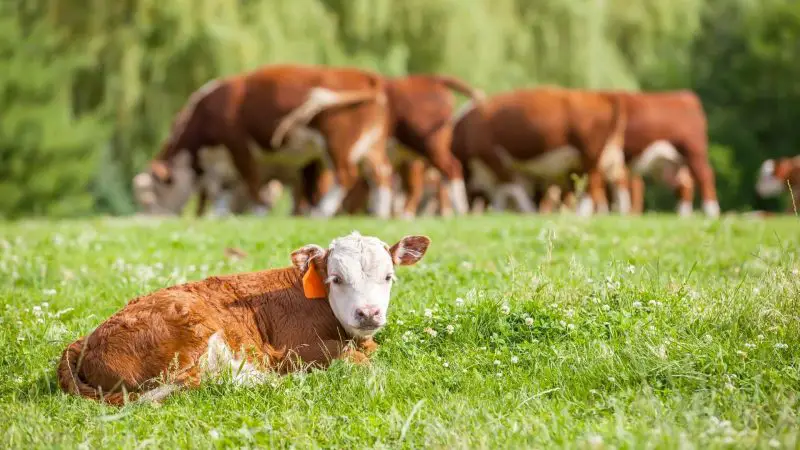
Clover is not toxic to cattle. However, moldy or wet sweet clover can lead to poisoning if consumption is too much. Clover can also cause pasture bloat to cows if you will mix with grass, and if clover is more than 50% of the mixture. Some types of clover have a higher potential to cause bloat than others.
What Is Pasture Bloat?
Pasture bloat is a digestive disorder where ruminants, including cattle, consume feeds that produce slimy, foamy gas that the animal cannot release via belching or burping.
Also called frothy bloat, this problem usually occurs when cattle graze on immature pasture or lush legumes or are fed with green-chopped legumes.
Once the trapped gases are not belched, the rumen (the largest stomach compartment) will gradually expand like a big balloon. In a herd, some cows have a higher susceptibility level against bloating than the others, while some have an inherited tendency for bloat.
To avoid further problems, such cows will be culled.
In severe cases, pasture bloat can cause restriction of blood circulation, which affects breathing. Unfortunately, cattle may die within 1 to 4 hours after grazing on a bloat-producing pasture for 12-48 hours if not treated immediately.
In short, bloat is a life-threatening condition that should be considered an emergency.
Symptoms of Pasture Bloating in Cattle
The following are the symptoms of pasture bloating in cattle:
- Swollen left side of the abdomen
- Feels uncomfortable
- Repetitive stomping of feet
- Always kicking its belly
- Frequent standing up and lying down
- Often extending its neck and head
- Grunting when breathing out
- Labored breathing
- Frequent discharge and urination
- Sudden collapse or death
Treatment of Pasture Bloating in Cattle
Treatment of pasture bloat in cattle is very much possible, but a few seconds of delay in acute conditions may be too late. For the record, frothy bloat is different from free-gas bloat, which is caused by physical obstructions such as apples, potatoes, etc. Here are the steps on how to treat pasture bloat:
Step 1: Don’t feed bloated cattle for a few hours and walk it carefully to help the bloat go down.
Step 2: If bloating still occurs, prepare a rubber hose or a stomach tube 8-10 feet in length and 3/4 to 1 inch in diameter. You may also need an anti-foaming agent, a large trocar needle, and a sharp knife.
Step 3: Slowly insert the tube inside the cow’s throat. Make sure that the animal’s head is steady.
Step 4: To help the cow release the gas, try to reposition the tube repeatedly.
Step 5: If the cow will release gas, the condition is free-gas bloat. You should identify the obstruction and remove it.
Step 6: If no gas is released and a foamy substance flows out of the tube, the condition is frothy bloat. For frothy bloat, don’t remove the tube from the cow if it does not provide relief. Administer an anti-foaming agent to the cow to break down the foamy substance. Follow the dosage instructions on the label.
Step 7: If the cow will still not release gas, the anti-foaming agent should be administered using the trocar needle. Ask your veterinarian for guidance.
Step 8: Closely monitor the behavior of the cow to check if bloat is still present.
Step 9: As a last resort, use a sharp knife to fully relieve the bloat. This treatment should be done in the presence of a veterinarian.
Note: You can treat pasture bloat by yourself, but it’s always better to ask assistance from a veterinarian.
Tips on Preventing Pasture Bloat
Prevention of pasture bloat involves proper pasture and cattle management, as well as providing diet supplements to your cows. Although bloating can occur any time of the year, the risk is higher in the fall due to the possibility of wet pasture. Below are some helpful tips in preventing if not reducing the risk of pasture bloat:
- Plant mixtures of legume and grass. Bloat-causing legumes should be less than 50 percent of the forage.
- During the growing season, closely monitor legume-grass proportion growth rates.
- If possible, plant non-bloating legumes only such as birdsfoot trefoil, cicer milkvetch, lespedeza, and sainfoin, also known as ‘holy hay’.
- To reduce and control the concentration of high bloat legumes, consider spraying herbicides or interseeding grasses on the area.
- Never allow hungry cows to pasture on areas with a high content of bloat-causing plants.
- Fill cattle with dry hay or grass before allowing them to graze high bloat-potential pastures.
- During the first sign of bloat symptoms, don’t remove the cows from the pasture or make frequent changes in the pasture. Cattle that consume higher fiber portions of the plant have a lower risk of bloat.
- Don’t allow cows to graze on high bloat-potential plants for a week after freeze damage.
- Feed the cows with molasses blocks with bloat-reducing compounds such as poloxalene and ionophore 2-5 days before turning them onto pasture.
- Cull the cows with recurring bloat problems.
Types of Clovers and Their Effects on Cattles
Not all clovers are the same, especially when it comes to causing pasture bloat. Although all of them are excellent feeds for cows, some of them can grow fungi or mold that can lead to poisoning. Below are the common types of clovers for cattle and their effects on them:
1. Alfalfa

Alfalfa is not a clover but rather a cousin in the same family. This nitrogen-fixing legume is one of the most nutritious forages for beef and dairy cattle. It is also an excellent source of protein and is good for pregnant cows.
Freshly harvested alfalfa is notably the best source of vitamin A, which is a common deficiency among cows.
Nonetheless, the use of alfalfa by grazing cattle has been limited because of its high tendency to cause pasture bloat. For this reason, the feeding of alfalfa should be in combination with a higher fiber feed such as grass hay.
Also, never feed hungry cows with leafy alfalfa, and don’t let leaves build up in their feed bunks.
2. Alsike Clover

Alsike clover is a short-lived legume that has similar nutritive value as white clover but is not as productive.
It serves as a nutritious feed to livestock, except for horses because of its toxicity that can lead to photosensitization (sunburn) and big liver syndrome. Cows are known for being very unlikely to be poisoned.
Unfortunately, the toxin responsible for alsike clover poisoning has not yet been determined. Alsike clover is not a poisonous plant.
The poison comes from the fungus Rhizoctonia leguminicola, which can also be found in both red and white clover. This fungus is responsible for the early symptoms in horses.
3. Balansa Clover
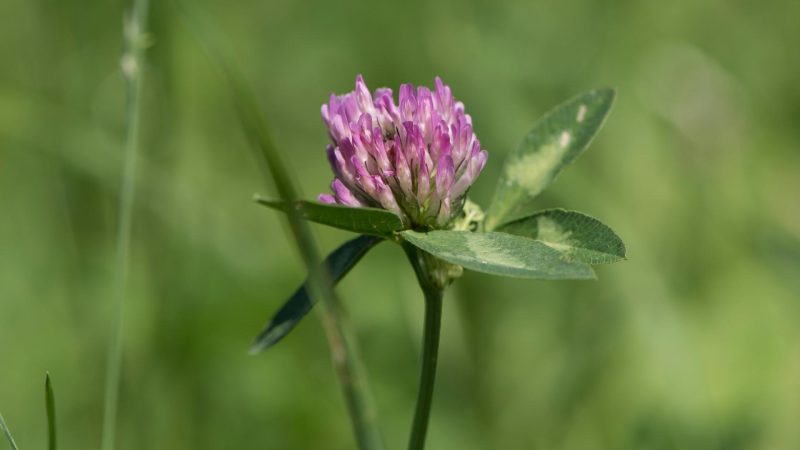
Balansa clover is an annual legume with a high nitrogen-fixing capacity and can be used for green manure, silage, or hay. It is considered a great alternative to white clovers during drought conditions and when soil drainage is poor.
This winter-active plant also performs well with perennial grasses such as ryegrass.
Balansa clover not only improves crop yields through nitrogen fixation but also provides valuable grazing for livestock including cattle. Interestingly, this versatile, self-generating forage crop typically does not cause pasture bloat compared to the other clovers. It is also non-toxic and does not cause poisoning.
4. Berseem Clover
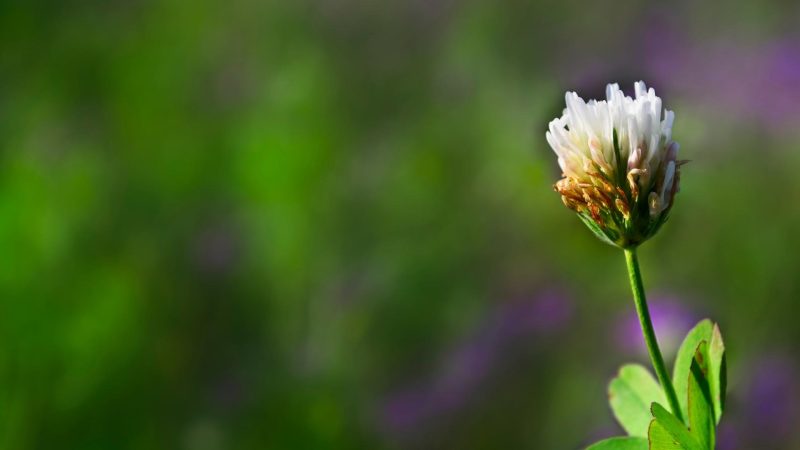
Berseem clover is a fast-growing summer annual plant that has 18-28% protein. Young berseem clover is also considered a better feed than alfalfa and crimson clover.
So far, there are no reported cases of bloat due to grazing berseem clover, which is why it is also being dubbed as a non-bloating legume.
Despite not being a good reseeder, berseem clover can be seeded with legume species. It germinates quickly (around 7 days), which makes it an ideal nursing crop for alfalfa.
A mixture of frosty berseem clover and alfalfa can increase hay yields by nearly 30%. Berseem clover with ryegrass also works well for cattle grazing.
5. Crimson Clover
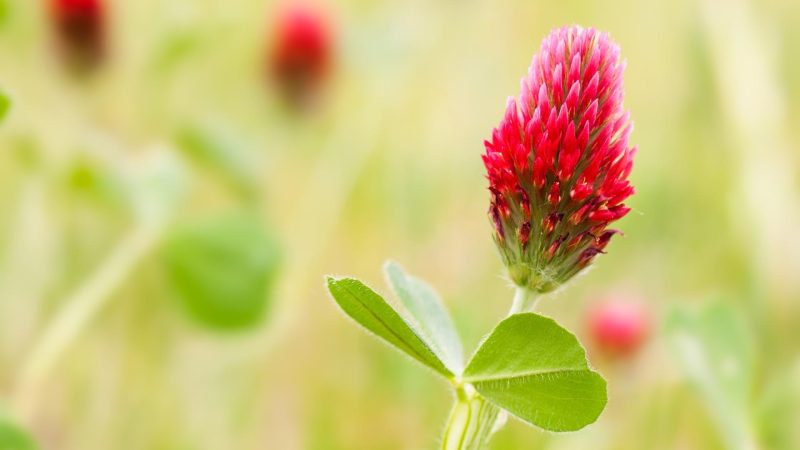
Crimson clover is a densely hairy annual plant that contains more than 25% of crude protein, which can be 80% digestible during its growth in the early spring.
At full bloom, dry crimson clover may contain 12-14% crude protein and 60-65% digestible nutrients. It also offers good grazing in cattle even before flowering.
When harvested during or before its mid-bloom stage, crimson clover also produces high yields of hay. Just like red clover, it is also moderate in terms of causing frothy bloat to cattle.
It is also much less likely to cause bloating compared to alfalfa and white clover. Mixing it with grasses reduces the risk.
6. Red Clover
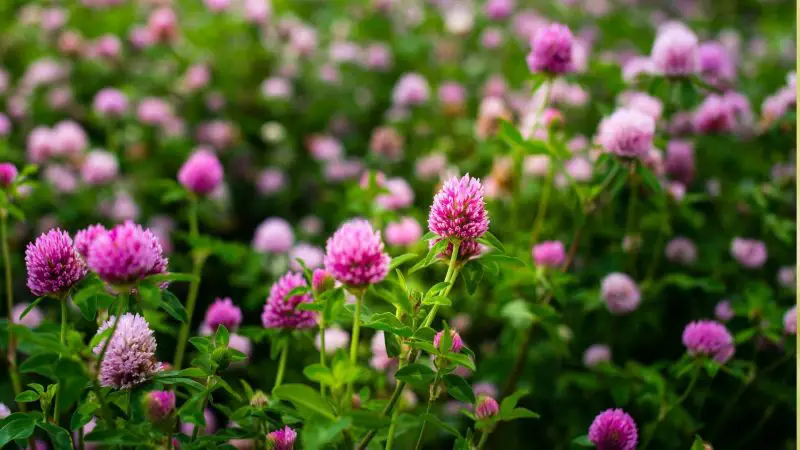
Red clover is a leafy legume that is not only valuable for soil improvement but also in the hay and pasture of dairy cows.
It contains an excellent nutritional value and high levels of digestible protein, but the level is a bit lower than that of alfalfa. Nonetheless, this biennial legume is moderately likely to cause frothy bloat.
Research at USDA-ARS concluded that red clover could be the best vasodilator for cattle, thus reducing blood pressure easily.
This is because it contains high levels of Biochanin A, an isoflavone that can cause blood vessels to expand. On the other hand, it’s hard to maintain a consistent level of red clover in a pasture.
7. Sweet Clover
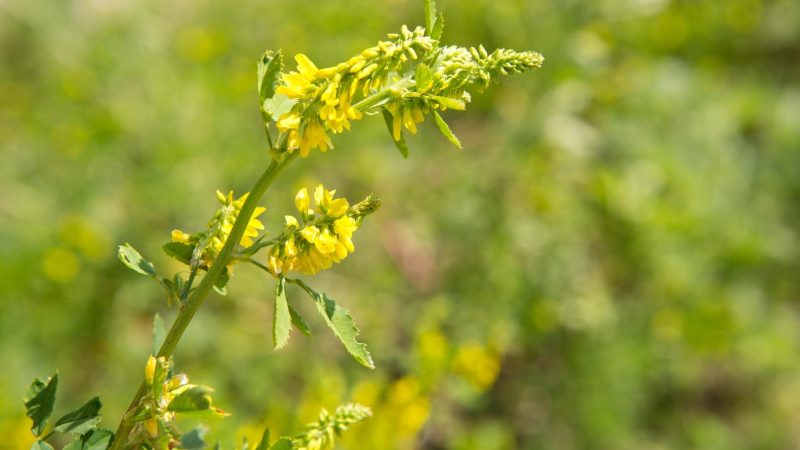
Sweet clover is a biennial plant that is excellent for feeding cattle and is abundant in the pasture during favorable conditions. This opportunistic plant is known for having similar fiber content as alfalfa but is less digestible.
It provides denser energy forage, making it a very valuable crop, especially to lactating dairy cows.
On the other hand, sweet clover contains a high level of a naturally occurring chemical compound called coumarol. In the presence of mold, this chemical is converted to dicoumarol, which can cause blood clotting.
To avoid sweet clover poisoning, hay with sweet clover should be completely dry before baling.
8. White Clover

White clover is a short-lived perennial that is especially valuable for dairy cows because it helps increase milk production. It has more nutritional characteristics as compared to ryegrass mainly because it has higher protein content and a lower structural fiber.
White clover also contains Biochanin A but only at lower levels.
But then, white clover is also as thick as a dog’s hair, and too much of it can cause cows to die due to bloating. In fact, pastures that are high in white clover have huge potential to cause pasture bloat.
This is why you should not clip a grass-legume pasture and then immediately allow your cows to graze into it.
Proper Management When Feeding Clover to Cows
Generally speaking, clover helps improve animal performance and increases yields. It adds nitrogen to grass pastures and hayfields and also supplies high-quality protein.
However, this palatable legume may also pose health risks to cattle if mismanaged. Here are some tips on proper feeding of clover to cows:
- Do rotational grazing on mid-day to help reduce clover moisture and increase plant carbohydrate concentration.
- Give cows a chance to choose the portions of pasture that were windrowed several days before grazing.
- Avoid making significant changes in forage quality during paddock rotation.
- Avoid feeding cows with clover in the morning. During these hours, clover contains dew, which motivates cows to overeat.
- Never feed your cows with moldy sweet clover.
- Always give cows a regular supply of water and minerals.
Frequently Asked Questions
Can Clover Kill Cattle?
Clover can kill cattle once they eat too much of it. Overconsumption of clover can result in pasture bloat, which can eventually lead to death if not attended immediately.
Also, ingestion of large amounts of moldy sweet clover hay can cause their blood to clot. Wet pastures with clover are very dangerous for cows.
Which Clover Is Best for Cows?
For cattle grazing, white clover seems to be the best choice. But for pasture, red clover is the ideal feed. However, white clover has a high potential to cause pasture bloat, while red clover is only moderate.
On the other hand, berseem clover is the best choice if you want to avoid your cows suffering from bloat.
Will Clover Take Over Grass?
Contrary to popular belief, clover will not take over grass even if you leave it untreated. In fact, it can help your lawn in preventing unwanted weeds.
Clover adds nitrogen to the soil, which is why using fertilizer is no longer necessary. But for the safety of your cows, don’t allow clover to cover more area than grass.
What Is the Best Grass to Grow for Cattle?
The best grass to grow for cattle depends on the type of grass suited for the climate. Cool-season grasses such as Kentucky bluegrass and perennial ryegrass are best for cows in the spring and fall seasons.
Meanwhile, warm-season grasses such as switchgrass and big bluestem are ideal in the summer.
Summary
Clover is safe for cows as long as it has no mold and toxins. The key here is to avoid pasture bloat, and poisoning is close monitoring of the eating habits of your cows.
You should also know the plants that can poison them. In some cases, symptoms will not appear at once, and treatment may no longer be possible.
List of Sources
Tips For Preventing Pasture Bloat
Protect Livestock From Sweet Clover Disease
